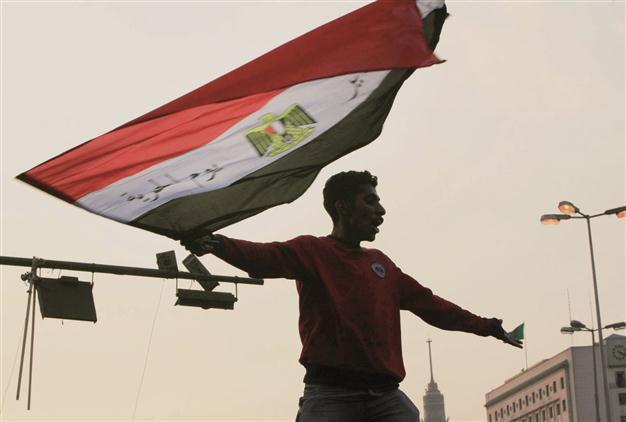Ultras learning from failures of past Arab revolutionaries
James M. Dorsey

Egyptian youths play football in Tahrir Square in Cairo. The battle lines between fans, the military and the Football Association (EFA) have hardened, threatening to disrupt Egypt’s Premier League. AP photo
The battle lines between militant football fans, the country’s ruling military and the Egyptian Football Association (EFA) have hardened, threatening to disrupt Egypt’s Premier League. Authorities and clubs postponed matches in a bid to prevent potentially violent protest against the government and the football body.
This week saw cancellation of a match between crowned Cairo club Al Ahly SC and Ismaily SC and a request by Ahly’s archrival, Al Zamalek SC for its game against Arab Contractors SC to be delayed because of anticipated fan violence. This follows last month’s pitched battles near Cairo’s Tahrir between security forces and protesters led by ultras - militant, highly politicized, violence prone football fans - who played an in important role in the protests that early this year toppled President Hosni Mubarak.
The clashes and Egypt’s first post-revolt election prompted the interior ministry to postpone the Ahly-Ismaily match, which was supposed to be played behind closed doors in line with the EFA’s penalizing of the Cairo club for earlier disruption of matches by Ultras Ahlawy, the clubs militant fan group. It also persuaded Zamalek to ask the EFA to postpone its match against Arab Contractors because security forces preoccupied with the election may not be able to focus on the match.
Ultras Ahlawy and its Zamalek counterpart, Ultras White Knights (UWK), have vowed to defy the EFA’s crackdown on their club support tactics, which involve the use of fireworks, flares, smoke guns, loud chanting and anti-EFA and government banners.
Besides banning spectators, the EFA, acting on instructions from the interior ministry, has warned clubs they would be fined $3,750 whenever fans set off a firecracker in a stadium. The instructions were reportedly handed down to the EFA by the Egyptian ministers.
The Ahly ultras and UWK have vowed to defy the EFA crackdown as part of their campaign to force the departure of the football body’s Mubarak era leadership and against corruption in Egyptian football.
At the core of the ultras’ defiance is the instinctive learning of the lessons from the failures of Arab revolutionaries in the 1970s and 1980s, like prominent Syrian poet Adonis and Marxist ideologue Yasin Al-Hafiz - whose calls for leaving no stone in society unturned were stymied by autocratic leaders cloaked in the mantle of Arab nationalism.
The ultras alongside other youth groups were determined in the months leading up to the first post-Mubarak elections to foil the military’s attempts at operating on the principle of “the emperor is dead, long live the emperor.” The military’s mishandling of the transition, crude attempts to undermine a democratic process and intimidation tactics sparked the November protests.
What began in November as a human barricade, predominantly created by ultras responding to a call from protesters in Tahrir Square for protection from the security forces bent on clearing the area, escalated into a battle with its own dynamics. Police faced off with protesters, who were armed with rocks, Molotov cocktails and homemade explosive devices. The ultras put their street battle experience, garnered in years of stadiums clashes, on full display as they went into action.
As the frontline in the “Battle of the Dakhliya (interior ministry)” or alternatively dubbed the Battle of Mohammed Mahmoud - the epicenter of the confrontation, just off Tahrir Square - moved at times closer to and then further away from the ministry. Chinese-made motorcycles carried the wounded to safety. Shamarikh, the controversial, colored fireworks employed by the ultras during football matches, lit up the sky at night replacing street lights that had been turned off.
Theirs was as much a battle for dignity as it was part of the fight to hold the military to its pledge to lead the country to democracy. Their dignity is vested in their ability to stand up to the dakhliya, the knowledge that they no longer can be abused by security forces without recourse and the fact that they no longer have to pay off each and every policeman to stay out of trouble.
Ironically, there was a shared sense between security forces and ultras that for the first time in five years of battles, it was the interior ministry forces rather than the fans fighting for their survival. The police’s tarnished image as enforcers of a brutal regime remained unchanged nine months after Mubarak’s downfall and if anything had been reinforced by the military’s refusal to hold police officers accountable for their brutality, despite pressure from the public as well as reform-minded security personnel.
The ultras and their fellow protestors this week moved away from Tahrir Square to the office of the Prime Minister to continue their protest in demand of an end to military rule. The battle lines may have hardened, but the move highlights the marginalization of the ultras and the protesters by electoral politics in which established political forces like the Muslim Brotherhood with the machinery and experience to exploit the transition for their own ends. Electoral politics have also produced the Salafis as a competitor in demanding a clean sweep in post-Mubarak Egypt.
